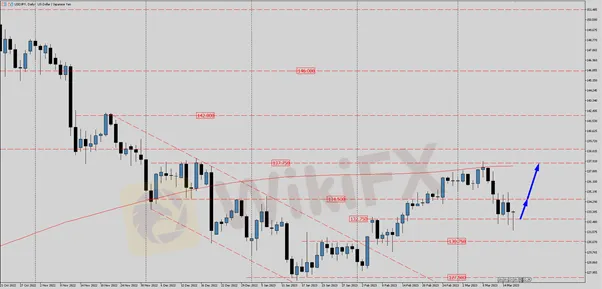Forex Chart Of The Day: USDJPY Price Finds Support At 132.75
Abstract: USD/JPY meets with a fresh supply on Friday and is weighed down by reviving demand for the JPY.

USD/JPY meets with a fresh supply on Friday and is weighed down by reviving demand for the JPY.
USDJPY Analysis
The USD/JPY pair struggles to capitalize on its modest gains recorded over the past two trading sessions and attracts fresh sellers following an early uptick to the 132.00 area on Friday. This could lead to the price of USDJPY trading back towards the key resistance levels. On a weekly time frame the price could be forming an inverse head and shoulders pattern which could see the price move much higher.
If the price does close above the 132.75 support on the daily time frame, we could look for the price to trade back to the previous highs and resistance of 134.50. A break above the 134.50 highs would lead to the price heading back to the daily 200 moving average and resistance of 137.75.
The price moving higher and reaching these levels will depend on the Federal Reserve rate decision next week. If the Fed holds rates or moves by the slower pace of 25 basis points, the market could move higher. A move to raise rates at a faster pace could cause further banking concerns which could drive prices back lower.
USDJPY

The price on the chart has traded through multiple technical levels and some observations included:
• Price is finding support at 132.75.
• If price holds above this level we could see a move to 134.50.
• A break above 134.50 would lead to a move towards 137.75.

Read more

Broker Comparsion: FXTM vs AvaTrade
FXTM and AvaTrade are two well-established online brokers offering forex and CFD trading across global markets. Both enjoy strong reputations and high ratings on WikiFX—FXTM holds an AAA overall rating, while AvaTrade scores 9.49/10, indicating they’re regarded as reliable choices by the community. However, since brokers have great reputation in the industry, how do we know which one is more suitable for individuals to invest in? Today's article is about the comparison between FXTM and AvaTrade.

Shocking Move: Yen Breaks Past 140 Barrier!
The yen's breakout above the 140 mark has caught global attention, and the reasons behind it are more than technical.

FINRA fines SpeedRoute for alleged rule violations
The Financial Industry Regulatory Authority (FINRA) has imposed a $300,000 fine on SpeedRoute LLC for a series of supervisory, risk management, and anti-money laundering (AML) program deficiencies spanning from 2017 to the present. Of this amount, $75,000 is payable to FINRA, with the remainder offset by SpeedRoute’s limited ability to pay. In addition to the monetary penalty, SpeedRoute has been censured and ordered to overhaul its compliance framework, including enhancing its written supervisory procedures (WSPs) for market access controls and strengthening its AML program.

Nigeria's Oil Crisis: How Are Stakeholders Responding?
Despite being rich in oil, Nigeria struggles with refining shortages. What’s behind this paradox, and how are different actors reacting?
WikiFX Broker
Latest News
Love, Investment & Lies: Online Date Turned into a RM103,000 Scam
Broker Took 10% of User's Profits – New Way to Swindle You? Beware!
Pi Network: Scam Allegations Spark Heated Debate
Broker Comparsion: FXTM vs AvaTrade
Account Deleted, Funds Gone: A New Broker Tactic to Beware Of?
Broker’s Promise Turns to Loss – Funds Disappear, No Compensation!
El Salvador and U.S. Launch Cross-Border Crypto Regulatory Sandbox
The Instagram Promise That Stole RM33,000
Coinbase Launches Bitcoin Yield Fund for Institutional Investors
Before You Trade the Next Big Thing, Remember the Dot-Com Collapse
Rate Calc

